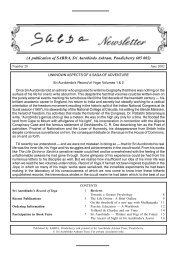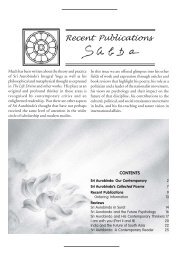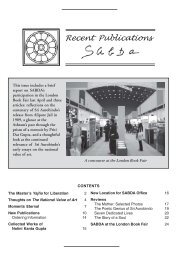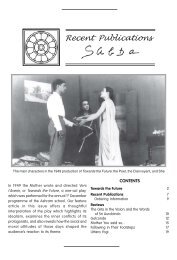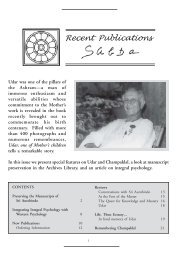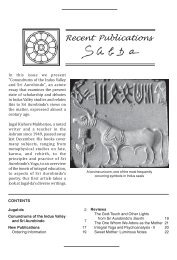Recent Publications - Sabda - Sri Aurobindo Ashram
Recent Publications - Sabda - Sri Aurobindo Ashram
Recent Publications - Sabda - Sri Aurobindo Ashram
You also want an ePaper? Increase the reach of your titles
YUMPU automatically turns print PDFs into web optimized ePapers that Google loves.
20 <strong>Recent</strong> <strong>Publications</strong><br />
few aspects connected with them. This presentation<br />
forms a basis for him to examine the poetic creations<br />
of <strong>Sri</strong> <strong>Aurobindo</strong>. Then we have a chronological survey<br />
of the short poems covering the entire period of his<br />
writings. Thus, commenting on one of the earliest lines<br />
of the poet, “Her life is but a bath of love”, it is<br />
suggested that the word “bath” could mean a tub-bath,<br />
or a shower bath, possibly both, but the sense of being<br />
saturated in love is what is conveyed by it, an original<br />
and apt image indeed. The sonnets of the later days,<br />
mostly written in the mid 30s, have a different<br />
character. Dr Pakle takes a number of them to illustrate<br />
the visual aspect present in them. To illustrate: “the<br />
symbolic visual image of golden light dominates the<br />
sonnet ‘The Golden Light’. The colossal transformation<br />
due to the Divine descent within the protagonist’s self<br />
is expressed by using visual images of ‘flame’, ‘wine’,<br />
‘temple’, ‘playfield’ and ‘seat’ illustrating the veritable<br />
changes that took place in his brain, throat, heart and<br />
feet.” This indeed is an important sonnet, written on 8<br />
August 1938, with rich autobiographical contents about<br />
the siddhi the yogi-poet had achieved. In that sense,<br />
his symbols, or visual images, go far beyond their<br />
immediate descriptive or literary connotations; they<br />
become living realities, powers that stand in front of<br />
us in vibrant and luminous form.<br />
The author then goes through the longer poems, mostly<br />
written during the Baroda period. He gives a number<br />
of examples of the poetic<br />
imagery present in them,<br />
bringing out the quality<br />
of the poems written in<br />
those early days. As an<br />
illustration, let us see the<br />
remark about the ‘star’<br />
image in Urvasie: “The<br />
poet sets before his<br />
readers the symbols of ‘star’ and Pururavas and Urvasie<br />
with purpose. They set an example of a Divine<br />
adventurer; and they anticipate the descent of the Light<br />
into the inner being of the whole human race, which<br />
gains thereby immortality. Immortality to <strong>Sri</strong><br />
<strong>Aurobindo</strong> is the spiritual continuity of the divinised<br />
soul rather than that of bodily existence. Really, it<br />
seems a very difficult task to separate the yogi from<br />
the poet, the mystic from the worldly man in <strong>Sri</strong><br />
<strong>Aurobindo</strong> and this unique achievement is the true mark<br />
of his exploration of symbolic potentialities in the<br />
objects that surround mankind.” Very true indeed.<br />
For <strong>Sri</strong> <strong>Aurobindo</strong> a symbol always<br />
expresses a living reality or inward<br />
vision or experience of things,<br />
making that experience a realisable<br />
possibility for awakened souls.<br />
Coming to the epics, about Ilion written in quantitative<br />
hexameter natural to the English language, Dr Pakle<br />
says that “the poet has achieved the rare<br />
accomplishment of making the abstract thing like the<br />
divine reality.” This has been done successfully “with<br />
the help of images of particularly visual and kinaesthetic<br />
and abstract kinds”. A fairly elaborate discussion of<br />
some of these aspects follows. Thus, about the images<br />
of Troy, we have a beautiful example in the following:<br />
Dreamed by the harp of Apollo, a melody<br />
caught in the marble,<br />
Out of his mind it arose like an epic canto by<br />
canto;<br />
Each of its halls was a strophe, its chambers<br />
lines of an epode,<br />
Victor chant of Ilion’s destiny…<br />
This Apollo’s epic, perfect in beauty as a visual symbol,<br />
has the power to set the destinies of men and countries<br />
into motion.<br />
The Savitri section in Image, Symbol and Myth in <strong>Sri</strong><br />
<strong>Aurobindo</strong>’s Poetry covers roughly one-fifth of the<br />
book. The author writes: “<strong>Sri</strong> <strong>Aurobindo</strong> has used here<br />
the myth of Savitri that certainly comes from the Vedas,<br />
the Upanishads and the Mahabharata. The myth of<br />
Savitri that he calls a legend, he intends to present in a<br />
more realistic vein. And he has presented it as a symbol<br />
of the triumph of Love over Death, his most<br />
favourite theme.” About the symbolism in<br />
Savitri: “The symbolism in Savitri, even by<br />
way of a tentative generalisation, one could<br />
say is multiple and complex. If the poem<br />
were considered as one integrated symbol,<br />
it could be read to mean (i) the poet’s<br />
spiritual autobiography, (ii) the genesis and<br />
history of human evolution, (iii) the<br />
dialectics of consciousness and reality, and (iv) the<br />
poet’s quest for an aesthetic perfection.”<br />
Surely, Savitri is all this. But, in the case of <strong>Sri</strong><br />
<strong>Aurobindo</strong>, reality is as much a symbol as symbol a<br />
reality; they become indistinguishable. What we get in<br />
that fused identity is the shining concretisation of the<br />
potentialities. When symbolism arrived in Europe<br />
following Mallarmé, who proposed the view that the<br />
act of creation lies in not naming but in suggestion, it<br />
was thought that the ever-changing objective world was<br />
not a reality but only a reflection, that all that one could



